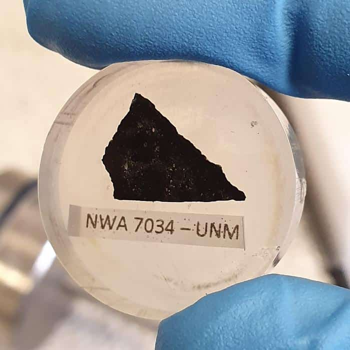Signs of hot water have been discovered in a Martian meteorite.
Science knows hundreds of fragments from the Red Planet that have fallen to Earth — Martian meteorites. These stones were once ejected into space from Mars’s surface due to impacts from large asteroids. Their origin is determined by the isotopic composition of gases contained in small amounts within the meteorites: satellite and lander data show that the Martian environment has a unique isotopic "fingerprint."
Among this rich collection, the NWA 7034 meteorite stands out. It was discovered in Morocco in 2011 and is now housed at the University of New Mexico in the United States. It is believed that its "homeland" is near the Martian crater Carata, located southwest of the famous Olympus volcano. According to scientists, it was an asteroid that left this trace that contributed to the ejection of the "Black Beauty" into interplanetary space. As one might easily guess, this nickname was given to the meteorite due to its striking color.
Planetologists emphasize that this is the first known sample of Martian breccia — a rock that is "cemented" from numerous fragments of different minerals. Primarily of volcanic origin, it is also highly hydrated: many water molecules have been "integrated" into the crystalline structure of the minerals. According to scientists, this is the most "watery" Martian meteorite known to date.

Finally, its age is estimated at 4.4 billion years. This means that the material formed 200 million years after Mars itself came into existence. It is worth noting that the Solar System is 4.6 billion years old. Therefore, the "Black Beauty" is also one of the oldest meteorites from the Red Planet.
Recently, researchers from Australia examined the "grain," or zircon inclusion, in the "Black Beauty" and found many "non-formula" elements in it, such as iron, aluminum, sodium, and magnetite. Moreover, the meteorite is highly "magnetized," confirming that Mars initially had a fairly strong magnetic field.
In an article for the journal Science Advances, scientists highlighted that such a wealth of "foreign" elements does not remain after the classic process of magma crystallization, but is possible in the presence of a large amount of hot water. The authors of the study concluded that the Martian zircon in the meteorite formed as a result of a significant hydrothermal event — the release of vast amounts of water from the planet's interior, where it had accumulated, heated, and created strong pressure within.
Finding so much water in this prehistoric stone is exactly what Mars researchers expected. The dried riverbeds and many other "identifying marks" on the surface suggest that in the distant past, the Red Planet had a full hydrosphere with oceans and rain clouds. Where all of this has gone remains a big question.
Some specialists believe that most of the water evaporated into space, while others argue that it "went underground." To clarify this, scientists want to reconstruct the chain of events from the very beginning. This is where the value of NWA 7034 lies: the meteorite shows that 4.4 billion years ago, water was already present on Mars and influenced the formation of its rocks.